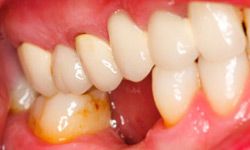Every time you visit the dentist for a checkup, there's one question you're almost certain to hear: "Have you been flossing regularly?" For a lot of patients, the answer isn't always yes. Many people make a point of brushing their teeth twice a day, as the American Dental Association (ADA) recommends, but fewer people follow the recommendation to floss at least once a day [source: ADA].
What many of these non-flossers don't realize is that this step plays an important role in dental health. Unlike a toothbrush, which cleans the tops and outer surfaces of the teeth and gums, floss is an interdental cleaner-- it's designed specifically to clean the tight spaces between the teeth and the gap between the base of the teeth and the gums. These are places that a toothbrush can't reach. And while antimicrobial mouthwash can kill the bacteria that form plaque, it can't remove the stubborn tartar and bits of food that can lodge in these places [source: ADA].
Advertisement
An increasing body of evidence suggests that proper dental care -- including regular flossing -- can do more than keep your smile pretty and healthy. A healthy mouth can also help prevent much more serious diseases, some of which can be life threatening [source: CDC]. But if you're still not convinced that you should add flossing to your daily routine, we've got five examples to make the case that flossing is extremely important, starting on the next page.


